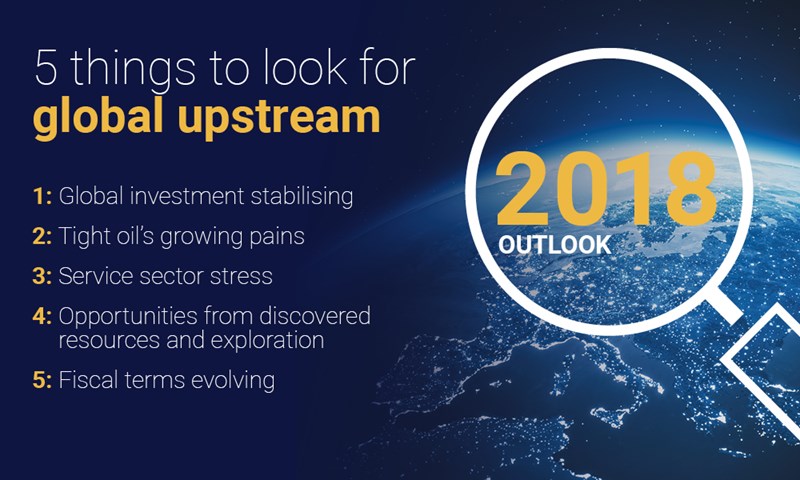Discuss your challenges with our solutions experts
1 minute read
Looking back, 2017 was the year when a glint of optimism returned to the upstream oil and gas industry. Will we see companies grow in confidence in 2018? With oil prices upwards of US$60 per barrel (bbl), investment stabilising, and new project sanctions on the rise, we think so.
Tight oil will enter its second great phase of growth, portfolios will be renewed, and more than 15 billion barrels of oil equivalent (boe) will be up for grabs.
Here are five key themes for the global upstream industry next year:
1. Global investment stabilising
Investment stabilised in 2017, and it will grow slightly in 2018, signalling an end to the cuts that saw more than US$900 billion taken out of global investment since 2014. We expect development investment of around US$400 billion, indicating that the cycle has bottomed out.
This is despite LNG spend collapsing 40% as projects are completed in Australia and Russia. The resulting gap will be filled by unconventionals and deepwater projects, where investment will be up 15% for both. After three years of decline for deepwater, this is a noteworthy shift, and we expect the Gulf of Mexico to be the big winner. We'll also see Brazil leading the way for major project FIDs in a third successive year of rising project sanctions – again signalling that the cycle is turning.
Tom Ellacott, Head of Corporate Research, joins Upstream Research Directors Angus Rodger and Malcolm Dickson to discuss growth strategies, the M&A market, and other key themes to watch for in 2018.
What will 2018 bring for the upstream oil and gas industry?
2. Tight oil's growing pains
We expect US tight oil production to surge 24% (1.2 million b/d) in 2018, driven by a 60% increase from the Permian. We believe most of the major players can deliver this growth while generating free cash flow above US$55/bbl. But rapid growth is not without its challenges.
Service-sector costs are already increasing, and operational hiccups and less experienced crews could also slow momentum. Drilling technology and subsurface challenges are additional risks.
We see breakevens rising as much as 15% for US tight oil next year, particularly in the booming Permian and Mid-Continent. But as it stands, there are more questions than answers when it comes to tight oil economics. We should have a clearer picture as 2018 plays out.
3. Service sector stress
It looks like 2018 will extend the tough run the service sector has had since the downturn. While oil companies have been adapting to the lower-for-longer cycle and moving toward growth, the service sector is still in survival mode.
Operators will continue to take advantage of an oversupply in the sector – there will be a great opportunity to lock in rock-bottom costs. There's also likely to be growth in operator-service sector collaboration, which is showing early signs of being an effective means to reduce pre-FID costs. And we expect more integrated supply chain players to move into the upstream operator space.
What to watch
Global upstream: 5 things to look for in 2018
4. Opportunities from discovered resources and exploration
Discovered resource opportunities (DROs) will play a big part in building up portfolios in 2018. Iran and the UAE could award at least 10 billion boe of discovered resources next year. There will be huge interest in exciting Latin American opportunities too, particularly in Brazil.
NOCs and the Majors will compete fiercely to access DROs and exploration blocks in Brazil, bolstered by world-class deepwater economics. Licensing rounds in Mexico will also draw strong bidding from these players, while independents will look for lower-cost licensing opportunities.
5. Fiscal terms evolving
Investment hotspots in Latin America have seen host governments maximise their share of future profits by allowing industry to bid the fiscal rates. Iran will almost certainly follow suit in 2018. Most other countries don’t have such prospective rocks to offer, yet many governments continue to insist on a high fiscal burden. This is deterring potential upstream investment.
In 2018, we expect to see more regimes open the fiscal rates to a bidding process, which should establish a more appropriate ‘market rate’. To incentivise lower-cost operations, some governments, like Indonesia and India, are opting for revenue-sharing agreements over profit-sharing. Will others follow?







